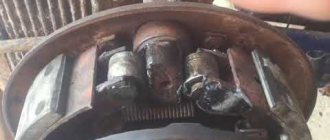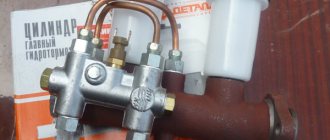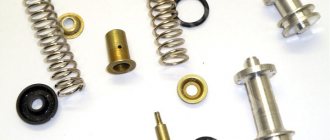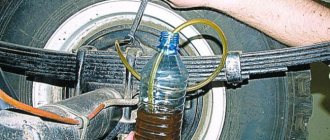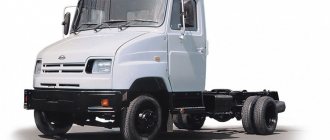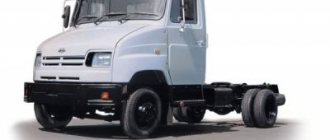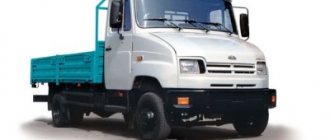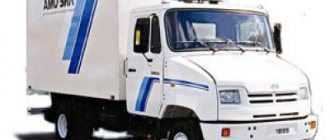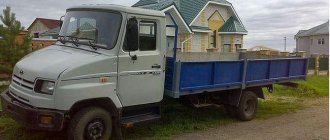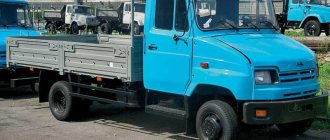Brake system ZIL 5301 bull, principle of operation - Special equipment
09.08.2017
ZIL-5301 “Bychok” was the first “swallow” of the Likhachev plant, which had not previously produced cars of this class. The new car went into production in 1995 and was produced until 2014.
During this time, the ZIL 5301 device was learned not only by specialists, but also by ordinary owners of these cars.
The repair scheme for this car is quite simple, so it is not difficult to do it in a garage.
The ZIL “Bychok” mini-truck is an excellent assistant in various situations
The light-duty truck brand 5301 of the Likhachev Plant, known as the ZIL “Bychok”, was put into mass production in 1995.
During its existence, the truck received many modifications and firmly took its place in the Russian truck market.
The main advantage of the model, which received the nickname “Bull” on the initiative of Yu. Luzhkov, is its accessibility.
Front wheel brakes
The design of the front wheel service brakes is shown in Figure 1.
Disassembling service brakes involves removing wheels and hubs with brake discs.
To remove the brake discs from the wheel hubs, you need to unscrew bolts 1.
Before disassembling the floating brake caliper, it must be thoroughly cleaned of dirt and washed, and the clamp must be removed from it.
21 hose fastenings. [td] fig. 1
Then you need to put a rubber hose on the bleeding valve 10 and lower its end into a clean vessel. Unscrew the bleeding valve one turn and, pressing the housing 11 of the bracket, push the cylinder pistons into the housing. In this case, a certain amount of brake fluid will leak into the vessel.
To dismantle the brake pads, you need to remove the pin 8 from the retaining pin 7 and pull out the pin. Then, holding the upper guide pin 13 from turning with a special wrench, unscrew the bolt 15 securing it to the axle body, protecting the rubber cover 14 of the pin from damage. Lift (rotate) the caliper body 11 relative to the second pin 17 until it stops in the caliper and remove the brake pads 6. Unscrew the nut 18 securing the auxiliary pin 17 and remove the caliper housing 11. Remove the piston dust covers 5 and carefully, so as not to damage the surface, push out the pistons 3 from the cylinders using compressed air.
| rice. 2 |
Remove sealing rings 4 from the grooves without damaging the inner surface of the cylinders.
Clean and rinse the brake mechanism parts with ethyl hydrolytic alcohol. The pistons must be washed especially thoroughly with alcohol. The use of other liquids for flushing is prohibited. Without wiping the parts, let them air dry on clean, glossy, lint-free paper.
Check the condition of all service brake parts. If the working surface of the piston is damaged or shows signs of corrosion, the piston should be replaced. If the cylinder surface is damaged, the bracket body must be replaced.
The surface of the brake discs must be smooth. Scratches and small scuffs that appear after normal brake operation are not a defective sign, but a disc with severe scuffing should be replaced.
If it is impossible to replace the disk, it can be grinded together with the hub. Sanding must be carried out by qualified personnel using special equipment. The polished surfaces of the disk must have a deviation from flatness of no more than 0.04 mm and from parallelism of no more than 0.04 mm and have a roughness of 0.8 microns.
The disc runout relative to the hub mounting surfaces should not exceed 0.1 mm. There should be no sharp edge on the inner circumference of the ground surface. Both sides of the disc should be ground the same amount, but the total thinning of the disc should not exceed 3 mm.
Before assembling the brake caliper, do the following:
Lubricate the working surfaces of the cylinders and pistons with unused brake fluid. Install new sealing rings 6 into the grooves of the cylinders of the bracket body 7.
Apply a thin layer of DT-1 lubricant to the surface of the cylinders up to the groove.
Carefully, so as not to damage the polished surface, insert pistons 5 into the cylinders with the open end facing outward.
Place the edges of new protective covers 15 on pistons 5. Lubricate the pistons in the area of the covers with DT-1 lubricant.
Place the free edges of the protective covers on the cylinders. By inspection it is necessary to determine the condition of pins 13 and 14, on the surface of which scratches, noticeable signs of wear and damage to the threads are not allowed; damaged pins must be replaced.
Remove bushing 16 of the auxiliary pin.
Clean the pins and holes for them in the calipers and wash them with alcohol. Install bracket body 11 onto caliper 1.
Place a new bushing 16 onto the auxiliary pin 17.
Lubricate the working surfaces of the pins with Molikot-Si 7439 or CIATIM-221 lubricant and insert the pins into the holes of the caliper 1. Install new protective covers for the pins 14 and tighten the mounting bolt of the guide pin 13 and the nut 18 of the auxiliary pin, protecting the protective covers from damage: Install on the bracket clamp 21 brake hoses 20.
After this, you need to install the brake caliper on the steering knuckle of the front axle and secure it as described in the articles “ Assembling the ZIL-5301 front axle
».
Attach the brake hoses to the bracket as shown in Fig. 3, without allowing them to twist, and attach them to the pipelines. Install brake pads 6 and secure them with pin 7. Install pin 8.
Bleed the brake system on the car by performing the following operations, keeping in mind that the hydraulic drive has two independent circuits.
Fill the brake system with Neva brake fluid according to TU 6-01-1163-78.
Fill the pneumatic drive with compressed air.
Press the brake pedal several times.
Add fluid to the tanks to the required level.
Remove the protective cap of the bleeder valve and place a rubber or plastic hose on the head of the bleeder valve of the rear left wheel cylinder. Place the free end of the hose into a transparent container partially filled with brake fluid.
Unscrew the bleeder valve one turn, smoothly press the brake pedal all the way and tighten the valve with slight force. Release the pedal. This operation should be repeated at intervals of several seconds until brake fluid comes out of the hose lowered into the vessel without air bubbles.
In this case, it is necessary to monitor the fluid level in the master cylinder tanks and replenish them as needed, not allowing the level to drop below the lower belts of the tanks.
After the appearance of air bubbles stops, tighten the bleeder valve while pressing the brake pedal.
In the same way, bleed the rear right brake and both front brake mechanisms.
After removing the hose from the bleeding valves, you need to thoroughly wipe the valves and put protective caps on their heads.
When the hydraulic drive is pumped, a pressure difference occurs in its circuits, displacing the piston of the signaling device, as a result of which the warning lamp lights up. To return the warning device to its original position, you need to unscrew the bleeder valve 1/2 turn, having first removed the protective cap from it, and, gently pressing the brake pedal, ensure that the lamp goes out. Then, keeping the pedal pressed, close the valve.
In case of replacing a set of front or rear brake pads, as well as at least one brake disc, it is necessary to break in the pads to the discs according to the following method:
— perform thirty moderate-intensity braking from a speed of 90 km/h to 30 km/h with an interval of at least two kilometers between braking;
— perform three effective braking on the verge of wheel locking from a speed of 80 km/h to a complete stop with a minimum interval between braking.
After replacing and running in the pads, it is necessary to check the operation of the brakes under road conditions.
Owner reviews about ZIL-5310 “Bychok”
valera163valera:
I took the “bull” a year ago, the car was built in 1997... I drove it for a year, I’m happy with the car. Of course, the car requires care, like any other. In order not to freeze in winter, I insulated the cabin. I agree about the brakes - they are weak, but if you try it yourself, the ZIL 5310 brakes will be normal. I missed the cuff on the steering bipod. I bought about 5 repair kits, of which only one turned out to be “high-quality”. Shock absorber pins often break; I haven’t found a quality one yet.
I only changed the high pressure pipe in the engine. no need to skimp on spare parts. so that the axles, axle shafts, and gearbox do not fly, there is no need to overload, this is not a five-ton truck. I travel 60-70 km. at one o'clock. I traveled to Moscow, Tula, Ulyanovsk, Ufa and a lot around Russia and it never let me down. if you drive 90-100 km. per hour, like some, you will have to constantly repair the car, this is a Russian truck, not a Ferrari.
One of the positive aspects is that the ZIL 5301 has an air brake system. I can't stand hydraulic ones.
requires constant syringing. I use semi-synthetic oil and it starts perfectly in winter. If you listen to how gazelles and all sorts of “Chinese” “roll around”, then the “bull” is a wonderful car in comparison with them. if the owner himself drives the bull, the car will earn money; if the driver drives it, then in a couple of months it will be possible to sell it.
NIKE:
Zil Bychok is a medium-tonnage vehicle, with a payload category slightly higher than a gazelle, but clearly inferior in quality. The car is slow, its cabin is not very comfortable, the landing seems to be vertical, the decoration is poor in the Zyl style. The body hardware is very weak, the car begins to rust after a couple of years, and through corrosion can appear after 5 years of daily use.
The units are not very good quality, for example the starter, this is a constant problem at Bychki. If the plant paid more attention to the quality of assembly and components, as well as painting, then the bull could be a competitor to the gazelle or compete with foreign manufacturers, but for now there is no point in talking about competition.
The cabin is the most favorite place for corrosion; it rusts and rots not by years, but by months. The plant could have paid attention to design and done some kind of restyling. In other respects, he is a Bull and in Africa he is a Bull. And they managed to call the car a cigarette butt, that’s what you call a ship and it will float. Although for the first 5 years the car is simply excellent, but then old age sets in.
Gavriil77777:
The car, like all cars produced in Russia or the CIS, has few advantages and many disadvantages. Let's start with the advantages: the price is not significantly high for a car of this level and carrying capacity; the engine, although from a tractor, works normally; the carrying capacity is pleasing; five tons of sinkers are not particularly strained; Well, now about the minuses: the cabin is simply huge in winter, it’s hard to heat, the valve on the compressor needs to be removed every fifteen hundred and washed, otherwise it starts working on its own: today “we” want to pump air, but tomorrow “I” change my mind; The seats are generally tough when driving on uneven roads, you can fly out from behind the steering wheel, the brakes are simply disgusting.
The body is also rather weak and had to be repainted every summer. In general, if you are engaged in construction or trade in building materials and you do not have money for a Ford or some other foreign car, then this car is for you, it will help you out and help you earn money. The main thing is not to overload and she will reciprocate.
How to bleed brakes without an assistant
How to pump the brakes with a partner has already been described above. What to do if there is no such thing nearby, but you need to bleed the brakes? You can get out of this situation in several ways:
- You can bleed the brakes alone if you have a gas stop . The meaning is the same as when pumping with an assistant, only instead of him the gas stop will press on the pedal. Therefore, you need to press the pedal several times, keep it pressed, set the stop and begin to bleed the brake fluid. When the fluid begins to flow, the stop will begin to push the pedal to the floor to the limit.
- bleeding the brakes with a syringe . You need to hermetically embed the syringe into exactly the same lid as on the tank. Then, having first filled the syringe with brake fluid, replace the regular cap with this device, unscrew the fitting, place a container and apply pressure with the syringe.
- another method with a modified lid . You need to insert a car nipple into a cap similar to the one installed on the tank. Then put the lid with the nipple on the tank, then put one end of the hose with a connection clamp on the lid, and the other on the spare chamber, inflated to no more than 1 atmosphere. Open the fitting and bleed out the liquid with air bubbles.
Bull brakes, rear and front | Zyl bull
ZIL “bull” received this name due to its resemblance to a similar animal, which is how the people nicknamed it. The people who have been using this car since the end of the 20th century and the beginning of the 21st century have never known grief. Although it depends on you, some people experience difficulties, even serious ones. It happens that the ZIL “bull” brake system also causes complaints. That's exactly what we'll talk about.
The ZIL “bull” brake system is a dual-circuit system. Each circuit is independent of each other. The first circuit includes the front right wheel and the rear left wheel, and the second circuit includes the front left wheel and the rear right wheel. The brakes are driven by a hydraulic system. But the brake booster is powered by pneumatics.
A spare brake is any circuit that has not failed. In more advanced models of the “bull” family, an anti-lock braking system (ABS) is installed on the brakes.
The handbrake is equipped with a mechanical drive, which is connected by a cable to the rear brakes. The front wheels are equipped with disc brakes, while the rear wheels are equipped with brake drums.
Also, a hydraulic pressure regulator is installed on the brake system of the ZIL “bull” car. With its help, when braking a car, the pressure of the brake fluid is distributed so that the rear wheels do not completely lock when the car is empty or not loaded to its full weight.
Well, so, what problems does the ZIL “bull” brake system cause for car enthusiasts?
Most argue that disc brakes fail after 15-20 thousand kilometers. And the discs themselves are crooked, which also reduces the service life of the front brakes and degrades the quality of braking. Another disadvantage some call is the inconvenient location of the barrel for the brake fluid of the rear wheels. It is located under the frame and is difficult to access.
As for the service life of the front brakes and their curvature, such problems were encountered in the first releases of the ZIL “bull”. In the “bulls”, which were produced a little later, such problems were not observed. And such problems can be corrected by boring the brake disc.
As for the location of the brake barrel, this is a design feature of the car, and there is no escape from it.
And finally, the last piece of advice: lubricate every 5 thousand km. run the caliper guide pin, and then you will not have any special problems with the bull brakes. A mixture of lithol and tada can be used as a lubricant.
Problems with brakes. | Topic author: Jereck
Good day to all. Just the other day I became the owner of a ZIL 5301 1999 - you can’t say it’s alive, but it’s tolerable.
Evgeny (Stela) encountered something similar on a gazelle - replacing the main one solved everything. It’s not worth taking a repair kit - r.. rare. Better get a new one. It's really expensive. When you remove the sorcerer correctly, he turns off the rear brakes on an empty car. In general, in theory, look at how the rod on the brake chamber moves (the one on which the turbocharger hangs). Maybe there's something sticking there.
Konstantin (Jenkin) Thanks bro.
Alexey (Rosalynd) most likely the front calipers are sticking, lubricate the pistons with graphite lubricant
Konstantin (Jenkin) It's the butt that bites!
Evgeny (Stela) what helped?
Konstantin (Jenkin) No, it didn’t work out - I bought a repair kit due to poverty. I'll try installing a new one, I just need to tweak it a little))) Thank you!
Konstantin (Jenkin) Hooray, there are brakes. I went through everything new, developed the cylinders and it worked. Thank you all for your participation, it wouldn’t have been possible without you. There is another problem, the brake pipes had to be plugged in some places, because... as a result of my labors, they were simply broken off. It’s impossible to find it on the Internet, has anyone found something similar?
Kostya (Vasanta) 4 months ago rebuilt the brakes, installed the main brakes on the UAZ Patriot with separated barrels, so far there are no problems with them and the price for them is 1200 rubles per piece. and safer. If anyone is interested, write.
Roma (Habimana) Why does the air not reach the rear brakes, the rod on the camera does not move and one of the receivers is EMPTY!! (closer to the front)
Zheka (Laisha) AAAA, the rear brakes are a pain in our car, I first separated the front and rear separately, the next stage was replacing the GTZ, I installed it from a gazelle, with the help of a file it fits onto our brake chambers like a native one, then I threw out the sprockets, so they bullied me , a minimum of alterations and voila, the gazelle eccentrics fell into place like family, I’ll post a photo this evening, I’ve just disassembled the rear hub, I’m going far at the end of the week, I need to check the lubrication.
Alexander (Wynn) The rear practically does not slow down, in winter the current is on the skid
Roma (Habimana) Kostya, the main worker installed it from the UAZ.
Roma (Habimana) Zheka, where are the photos? )
Zheka (Laisha) Roman, I gave up hydraulics and installed 2pts4 brakes in May
ZIL MMZ-4502 LNG DUMP TRUCK | Topic author: 65115
people I want to install a D-245 engine on a ZIL, is it worth installing or what? #diesel
Andrey (Hamayoun) bet it, you won’t regret it. Will you bet it yourself or a company?
Andrey (Hamayoun) And there is a minimum of alterations.
Andrey (Hamayoun) If the engine is from a bull or from Valdai, then it’s a fairy tale.
Sergey (Kacie) Install. Power and fuel economy. Don’t forget mud tires with a winch, just in case.
65115 (Penwyn) we have a ZIL 131 dump truck with a winch
65115 (Penwyn) I think we can handle it ourselves, or is it that difficult?
65115 (Penwyn) from a steer and take it, or from a bison maz
Andrey (Hamayoun) there is nothing complicated. The mounts from the bull engine are one-on-one with the engine. You won’t have to tinker with the hydraulic system much, and then only with the reservoir.
65115 (Penwyn) now we need to raise money to buy the engine. gasoline is no longer profitable; gas was supplied and now it’s 20 rubles per liter
Andrey (Hamayoun) advice is free. Look for a bull, prices for them have dropped dramatically. A week ago a neighbor sold a bull for 75,000.
65115 (Penwyn) we also have a working engine for 50,000
Andrey (Hamayoun) with the box together?
65115 (Penwyn) no
65115 (Penwyn) they put the Zilov box in?
Andrey (Hamayoun) Well, yes, only the input shaft needs to be cut.
65115 (Penwyn) there is also a d-645 engine with a gearbox for 60 thousand, it was removed from a working car but they say it is capricious
Andrey (Hamayoun) has never met anyone like this, so I can’t say anything.
How to check the interior temperature sensor of a VAZ 2110
How to remove the radio on Renault Megane 2
How to remove the stove on a VAZ 2115 video
How to install a UAZ GTZ on a ZIL bull: comments
I think you are making a mistake. I can defend my position. Write to me in PM, let's discuss.
Modifications
ZIL-5301AO
- Length in mm -3750 (cabin)
- Width in mm - 2254
- Height in mm -2365
- Weight in kg -3695
- Load capacity in kg -3000
- Wheelbase (total) -3650
- Ground clearance in mm -180
- Wheelbase front/rear -1690/1832
- Permissible load on the front/rear axle in kg - 1900/1995
- Power in hp -108
- Transmission - 5 speed mechanical
- Maximum speed in km/h - 95
- Fuel tank volume in l - 125
- Fuel consumption per 100 km in l -16
ZIL-5301BO
- Length in mm -6165
- Width in mm - 2254
- Height in mm -2365
- Weight in kg -3695
- Load capacity in kg -3750
- Wheelbase (total) -3000
- Ground clearance in mm -180
- Wheelbase front/rear -1690/1832
- Permissible load on the front/rear axle in kg - 2350/4900
- Power in hp -108
- Transmission - 5 speed mechanical
- Maximum speed in km/h - 95
- Fuel tank volume in l - 108
- Fuel consumption per 100 km in l -16
ZIL-5301G
- Length in mm -3750
- Width in mm - 2254
- Height in mm -2365
- Weight in kg -3695
- Load capacity in kg -3000
- Wheelbase (total) -3650
- Ground clearance in mm -180
- Wheelbase front/rear -1690/1832
- Permissible load on the front/rear axle in kg - 1900/1995
- Power in hp -108
- Transmission - 5 speed mechanical
- Maximum speed in km/h - 95
- Fuel tank volume in l - 125
- Fuel consumption per 100 km in l -16
ZIL-5301DO
- Length in mm -4385
- Width in mm - 2254
- Height in mm -2365
- Weight in kg -3820
- Load capacity in kg -3000
- Wheelbase (total) -3650
- Ground clearance in mm -180
- Wheelbase front/rear -1690/1832
- Permissible load on the front/rear axle in kg - 1900/1995
- Power in hp -108
- Transmission - 5 speed mechanical
- Maximum speed in km/h - 95
- Fuel tank volume in l - 125
- Fuel consumption per 100 km in l -16
ZIL-5301EO
- Length in mm -6765
- Width in mm - 2210
- Height in mm -2365
- Weight in kg -3050
- Load capacity in kg -3700
- Wheelbase (total) -3650
- Ground clearance in mm -180
- Wheelbase front/rear -1690/1832
- Permissible load on the front/rear axle in kg - 1900/1995
- Power in hp -108
- Transmission - 5 speed mechanical
- Maximum speed in km/h - 95
- Fuel tank volume in l - 125
- Fuel consumption per 100 km in l -16
